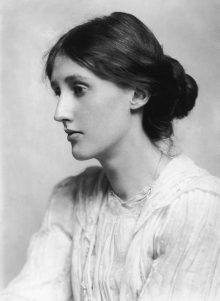Time and Identity in Virginia Woolf’s Work
Article By Ana Luisa Lellis
 One could say that most Western writers from the beginning of the 20th century have pondered upon questions of time and identity. Many authors, arguably inspired by technological developments and by the social impacts of the First World War, began to consider how the changes of the turn of the century mirrored onto individuals and their personal relationships. As Virginia Woolf remarks in her essay Mr Bennet and Mrs Brown, 1924, “all human relations have shifted – those between masters and servants, husbands and wives, parents and children. And when human relations change there is at the same time a change in religion, conduct, politics, and literature”.
One could say that most Western writers from the beginning of the 20th century have pondered upon questions of time and identity. Many authors, arguably inspired by technological developments and by the social impacts of the First World War, began to consider how the changes of the turn of the century mirrored onto individuals and their personal relationships. As Virginia Woolf remarks in her essay Mr Bennet and Mrs Brown, 1924, “all human relations have shifted – those between masters and servants, husbands and wives, parents and children. And when human relations change there is at the same time a change in religion, conduct, politics, and literature”.
In England, the end of the Victorian Era also marked a rupture with decades of conservative tradition. The feeling of liberation merged into a sense of uprootedness, and the aesthetic innovations of the modernist movement were a natural reaction to the pressures and transformations of the period. The new and fluid perception of reality needed an original means of expression. Virginia Woolf pursued and perfected a narrative device that could convey the human mind and the “whole of human life”, as she describes in her diary.
Born in London in 1882, Woolf is considered one of the most important modernist writers of her time. Her works depict perfectly this mixture of adventurous experimentation and melancholic tone. Almost all the elements of her prose are presented as a reflection of her characters’ consciousness. Places, actions and dialogues are described through the stream of consciousness of her protagonists and minor characters. Woolf tries to reach an objective reality by capturing transient perceptions, memories and thoughts of all her characters. With this, the author also draws attention to the subtle changes that occur over time, both within ourselves and in the world around us.
By diving into her characters’ minds and blurring the boundaries between past, present, and future, Woolf reveals how inseparable our identity is from time. Her narrative often captures the fleeting and elusive quality of time and, paradoxically, creates a sense of timelessness.
For Virginia Woolf, time was a constant source of fascination, a force that shaped and reshaped our world in ways both subtle and profound. On the one hand, she was acutely aware of the fleeting nature of time, of the way in which it could slip through our fingers like sand. On the other she also understood the power of the present moment.
In her essay Modern Fiction she proposes: “Let us not take it for granted that life exists more in what is commonly thought big than in what is commonly thought small”. This is the foundation of all of Woolf’s work. By registering a series of impressions upon the conscious mind she praises details of the transient moment. Internal shifts, which some would call small or insignificant, rise to our attention and are established as more important than exterior circumstances in her work. As she seeks to capture “life itself going on”, the author always tries to reach the centre of what lies beneath everyday life, a hidden truth linked to the meaning of being human.
Woolf explores the fluidity of time in the context of a single day in Mrs. Dalloway. The novel follows the protagonist, Clarissa Dalloway, as she prepares for a party she is hosting that evening. As she goes about her day, she reflects on her past, her present, and the future that lies ahead. Throughout the novel, the passing of time is underscored by Big Ben’s rings. So, it is revealing that the working title of Mrs. Dalloway was The Hours, as the novel displays time as a personal experience, a constant flow, interrupted by the chronological time hammered by the clock.
Chronological and psychological time are also counterposed in her following novel, To The Lighthouse. The book is divided into three sections – “The Window”, “Time Passes” and “The Lighthouse” – and each of them takes place in the same house but at different points in time. While the first and the third sections are longer and delve into minute details of a single day, the intervening chapters of part two compresses an entire decade, during which the First World War begins and ends, into twenty pages. Here, the external, material world – where a sense of absence and decay are linked to the relentless passage of time – is entwined with a primarily intuitive and subjective understanding of the world.
In these novels, Virginia Woolf conveys the general through the particular, society through the individual, a whole life through the course of a single day. She continuously investigates the meaning of identity throughout all of her work. With this, the boundaries of time and space are mostly surpassed in view of a broader sense of being human.
Both Clarissa Dalloway and Mrs Ramsey, from To the Lighthouse, symbolise this state of being which Virginia Woolf tries to capture. They seem to be attuned to “a general sense of the poetry of existence”, as Woolf describes in her diary, the “moments of being”.
Virginia Woolf can serve as a lighthouse to all of us who know that the subjective and intangible is as important as and, perhaps, more enduring than the concrete and material reality. Simply by directing our attention to minute details of day-to-day life, she inspires us to lift the passing moment out of the flow of time and make it permanent as a piece of art.
Image Credits: By Filippo Venturi Photography Blog | Wikimedia Commons | CC BY PD
The entity posting this article assumes the responsibility that images used in this article have the requisite permissionsImage References
By Filippo Venturi Photography Blog | Wikimedia Commons | CC BY PD
Permissions required for the publishing of this article have been obtained




What do you think?